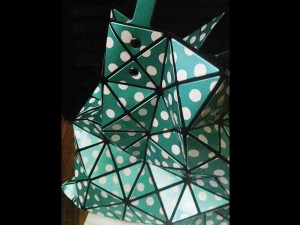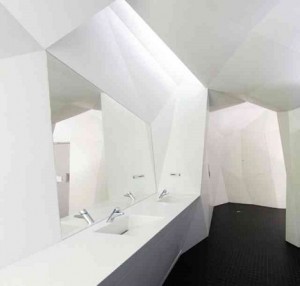Design’s many facets

THE BAO BAO bag’s facets collapse into their own form: shapes made by chance. Photo courtesy of Deluxemall
While design is primarily a product of artistic inclinations, technology undoubtedly supports the development of design. Take for instance the advancement of computer-aided design: Once used to draw two-dimensional plans, it has now extended into developing three-dimensional models, enabling them to turn and twist, much like a fashion model working the catwalk, and allowing its creator to study its forms from all sides.
Visualizing faceted forms and surfaces can be quite challenging and so the current trend of “faceting” in architecture and design is assisted, if not fueled, by digital technology. Facets make use of flat planes, oftentimes with only three sides, or with edges that connect to adjacent surfaces at different angles. Think origami. Think crystals.
Futuristic look
How can you accurately draw by hand planes that are set as various shapes and tilted at different angles? I personally struggle with this. It takes the precision of digital imaging to connect and close these into a continuous form.
I’m fascinated by the futuristic look that faceting creates. It will be unusual to find any two surfaces at a 90-degree angle or at a right angle. While the planes with no curves move with grace as they turn into various angles and “flow” to create other forms, one cannot help but appreciate its futuristic vibe, and not-any-graceful fluidity. It is hard-edged and crystalline, and quite revolutionary.
Take as an example the Lamborgini Countach, the Italian super car launched with much fanfare and controversy back in 1974. Considered to be very aggressive in form given its lack of curved surfaces, it was probably one of the first design creations made through faceted planes.
Although the Lambo’s facets were not very many considering how many sides and edges it had, it was already ahead of its time. But its new Aventador and Reventon, both with a tremendous amount of faceting on their bodywork, look like some slick super hero’s backup car: very modern—and definitely futuristic.

FORCEFUL YET GRACEFUL Seamless facets allow for a very futuristic fluidity in this washroom. Photo courtesy of DuPont
Pixelated effect
Issey Miyake’s popular line of ladies’ bags, the “Bao Bao,” works with facets too. Its flat and regular triangles in various colors have a two-dimensional pixelated effect when seen from afar. The “pixels” are cut from leather and are individually mounted on a fine mesh lining.
The bags come into their own original and unusual shapes as the flat triangles form three-dimensional arrangements as the bag “crumples” when carried, clutched or is put down. Its range of bags in monotone and metallic colors come alive when the facets move at various angles and pick up light and shadow that define forms. As others have noted, the bags have their “shapes made by chance.” Thanks to the facets.
At the Perth Cultural Centre Precinct, the washrooms have fully sculpted walls and ceilings. The use of white for the material—in this case, a seamless Corian brand solid surface—highlights the geometry of the ceilings, walls and skylit surfaces. The effect is that of walking into a modern cave made of crystalline material, like the inside of a randomly cut stone, lacking only in the high-polish of a quartz.
In this case, the synthetic material supported the seamlessness. But the way the surfaces were faceted as conceptualized by its designer dictated the final forms and the user experience. In all its angular geometry, the forms look both elegant and forceful.
Many other buildings and their exteriors are coming to play with facets. What it offers us is some fluidity in shape without being too organic. It projects modernity and the cutting-edge. Hopefully, it isn’t just a trend but rather a technique that’s slowly shaping the future.
Contact the author through designdimensions@abi.ph or through our Asuncion Berenguer Facebook account.
